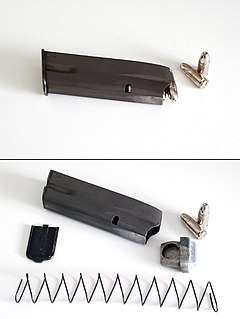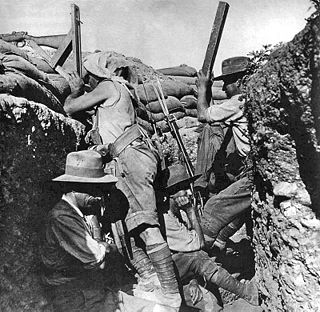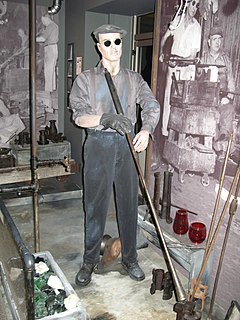
Bolt action is a type of firearm action where the handling of cartridges into and out of the weapon's barrel chamber is operated by manually manipulating the bolt directly via a handle, which is most commonly placed on the right-hand side of the weapon. When the handle is operated, the bolt is unlocked from the receiver and pulled back to open the breech, allowing the spent cartridge case to be extracted and ejected, the firing pin within the bolt is cocked and engages the sear, then upon the bolt being pushed back a new cartridge is loaded into the chamber, and finally the breech is closed tight by the bolt locking against the receiver.

Chatham-Kent is a single-tier municipality in Southwestern Ontario, Canada. Mostly rural, its population centres are Chatham, Wallaceburg, Tilbury, Blenheim, Ridgetown, Wheatley and Dresden. The current Municipality of Chatham-Kent was created in 1998 by the merger of Kent County and its municipalities.

The Ross rifle is a straight-pull bolt action .303 inch-calibre rifle that was produced in Canada from 1903 until 1918.

The M1903 Springfield, formally the United States Rifle, Caliber .30-06, Model 1903, is an American five-round magazine fed, bolt-action service repeating rifle, used primarily during the first half of the 20th century.
A repeating rifle, or repeater for short, is a single-barrel rifle capable of repeated discharges following a single ammunition reload, typically by having multiple cartridges stored in a magazine and then fed into the chamber by the bolt via either a manual or automatic mechanism, while the act of chambering the rifle typically also recocks the action for the following shot. In common usage, the term "repeating rifle" most often refers specifically to manually-operated weapons, as opposed to self-loading rifles, which use the recoil and blowback of the previous shot to cycle the action and load the next round, even though all self-loading firearms are technically a subcategory of repeating firearms.

The Martini–Henry is a breech-loading single-shot lever-actuated rifle that was used by the British Army. It first entered service in 1871, eventually replacing the Snider–Enfield, a muzzle-loader converted to the cartridge system. Martini–Henry variants were used throughout the British Empire for 30 years. It combined the dropping-block action first developed by Henry O. Peabody and improved by the Swiss designer Friedrich von Martini, combined with the polygonal barrel rifling designed by Scotsman Alexander Henry.

During World War I, the United States secretly developed the Pedersen device attachment for the M1903 Springfield rifle that allowed it to fire a .30 caliber (7.62 mm) pistol type cartridge in semi-automatic mode. This attachment was developed to allow an infantryman to convert "his rifle to a form of submachine gun or automatic rifle" in approximately 15 seconds.

A magazine is an ammunition storage and feeding device within or attached to a repeating firearm. Magazines can be removable (detachable) or integral (internal/fixed) to the firearm. The magazine functions by moving the cartridges stored within it into a position where they may be loaded into the barrel chamber by the action of the firearm. The detachable magazine is often colloquially referred to as a clip, although this is technically inaccurate.

The Lee–Metford rifle was a bolt action British army service rifle, combining James Paris Lee's rear-locking bolt system and detachable magazine with an innovative seven groove rifled barrel designed by William Ellis Metford. It replaced the Martini–Henry rifle in 1888, following nine years of development and trials, but remained in service for only a short time until replaced by the similar Lee–Enfield.

The Rifle, .303 Pattern 1914 was a British service rifle of the First World War period. A bolt action weapon with an integral 5-round magazine, it was principally contract manufactured by companies in the United States. It served as a sniper rifle and as second line and reserve issue until being declared obsolete in 1947. The Pattern 1914 Enfield was the successor to the Pattern 1913 Enfield experimental rifle and the predecessor of the U.S. Rifle M1917 Enfield.
The origins of the modern British military rifle are within its predecessor the Brown Bess musket. While a musket was largely inaccurate over 80 yards, due to a lack of rifling and a generous tolerance to allow for muzzle-loading, it was cheaper to produce and could be loaded quickly. The use in volley or in mass firing by troops meant that rate of fire took precedence over accuracy. A similar tactical preference would be a factor in considerations regarding rifle design in the late 19th century to early 20th century, when rate of fire would be a key design consideration for British bolt-action rifles.

James Paris Lee was a British and later American inventor and arms designer, best known for inventing the action and magazine used in the Lee–Metford and Lee–Enfield series of rifles.

A periscope rifle is a rifle that has been adapted to enable it to be sighted by the use of a periscope. This enables the shooter to remain concealed below cover. The device was independently invented by a number of individuals in response to the trench warfare conditions of the First World War, and while it is not clear which army was the first to use periscope rifles, the weapons were in use by the end of 1914. Similar devices were also built for use with machine guns.

The Sharps-Borchardt Model 1878 is a single-shot hammerless falling-block action rifle designed by Hugo Borchardt and made by the Sharps Rifle Manufacturing Company. It closely resembles older Sharps Rifles but has a firing mechanism that uses a hammerless striker rather than a hammer and firing pin like the old Sharps Rifle. This hammerless dropping-block breech-loader was based on a patent granted to Hugo Borchardt in 1877. It was the last of the Sharps single-shot rifles, and the Borchardt did not sell very well. According to company records 22,500 rifles were made in all models from 1877 until the Sharps Rifle Co. closed down in 1881. Although it was designed for the huge black powder "buffalo" cartridges of the day, it came too late, at the very end of the great bison slaughter.

Arthur William Savage, was a businessman, inventor, and explorer. He is most famous for inventing the Savage Model 99 lever-action rifle, which remained in production for over 100 years, and founding Savage Arms. However, his most lasting and valuable inventions may be radial tires, and it has been argued, the modern detachable box magazine used in almost all modern military firearms. He also invented an early torpedo and built and raced cars.
The Rieder Automatic Rifle was a fully automatic Lee–Enfield SMLE rifle conversion of South African origin. The Rieder device could be installed quickly with the use of simple tools. A similar weapon of New Zealand origin was the Charlton Automatic Rifle.
The Lee-Speed rifle was a bolt action rifle based on James Paris Lee's rear-locking bolt system and detachable magazine. Early models were fitted with barrels using the radiused rifling designed by William Ellis Metford. while later models used the same square "Enfield" rifling as contemporary British military rifles.




















